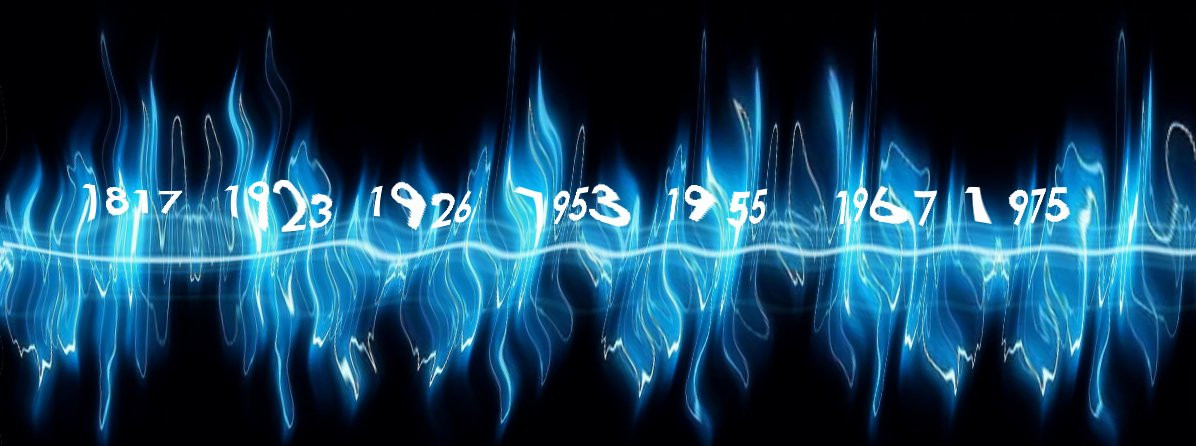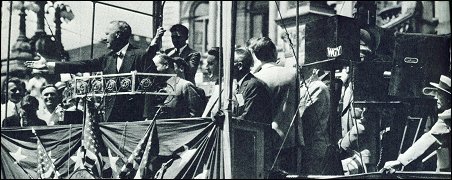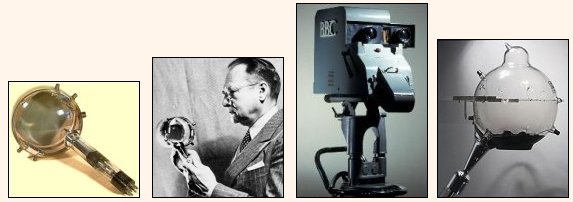
Television Timeline - 1931 to 1936

1931 – John Logie Baird begins to experiment with ultra-shortwave transmissions. Medium waves, as used by the BBC, permitted no more than a certain amount of detail, which limited Baird to transmissions of 30 lines. Their main advantage was their ability to carry signals for hundreds of miles. Ultra shortwave allowed much more detail but limited the range to about forty miles, although a series of relay transmitters would allow the pictures to go much further.
1931 – David Sarnoff of RCA offered to buy Farnsworth's patents for $100,000, but was refused; in June of that year Farnsworth joined the Philco Company - Philadelphia Storage Battery Company (formerly known as the Spencer Company and later the Helios Electric Company, was a pioneer in early radio and television). and moved his laboratory to Philadelphia.
(/wiki/Philo_T._Farnsworth)
1931 – Professor E. T. S. Walton stated: “If television is to be done successfully it must be done using cathode-ray tubes. The mechanical methods are doomed to failure.” In the same year Isaac Schoenberg began research into an electronic television system with a Marconi team (in 1934 it became Marconi-EMI). Iconoscopes had been built which had clearly demonstrated the advantages of the electronic camera over pick-up techniques. Although tremendous efforts of a technological and organisational nature were needed to establish television as an essential part of 20th century culture, the main roadblocks to further progress had been removed. The new EMI team, headed by Shoenberg, who, like Zworykin, had been a pupil of Rosing and had worked for the Russian Marconi Company included a number of brilliant scientists such as Alan Blumlein and William Tedham. The team first looked to develop cathode-ray receivers, retaining mechanical scanning for generating the picture.
1931 – Russia (later) claims that they designed a camera very much like Vladimir Zworykin’s. The man who invented it, Semyon Katayev, put in a patent application similar to the Iconoscope – calling his invention a ‘radio eye.’
(Various)
1932 – On 29th April John Logie Baird gave a demonstration from his ultra-shortwave transmitter at Long Acre, the pictures being transmitted to a 30-line receiver at Selfridge's.
1932 – Major organisational changes took place at Baird Television Ltd (BTL). After funding shortages, a takeover was engineered with control passing to Isidore Ostrer and the Gaumont-British Film Corporation.
1932 – In May the BBC were ready to start their own research into television production. To aid them they set up their first TV studio in the recently purchased Broadcasting House and employed their first television engineer, Douglas Birkinshaw. D. R. Campbell and Thornton Bridgewater from the Baird Company joined him and Baird's equipment was installed in the new premises.
1932 – J. D. McGhee, a nuclear physics research student at the Cavendish laboratory in Cambridge joined the EMI team and began work on the development of the cathode-ray tube that operated on all-electronic lines.
1933 – Work commenced at EMI on an electronic camera tube after Vladimir Zworykin's paper was published.
1933 – A boardroom coup at Baird Television Ltd ousted John Logie Baird from his duties, though he retained the title of managing director.
(/tv/technology/technology3.html)
1933 – July - Baird Television Limited moved to a new facility at The Crystal Palace in Sydenham, South London which was rapidly being equipped as a world-class television station and receiver manufacturing plant, while Baird was effectively banished to the laboratory attached to his new house nearby, free to develop new technologies but effectively locked out of the day-to-day running of the company and brought out primarily to meet the press.
(/tv/technology/technology3.html)
1934 - Ready to unveil its new television system, RCA purchase Kálmán Tihanyi patents for his storage principle. These covered controlling features that the U.S. Patent Office patent examiners, citing Tihanyi's prior publications, had denied several key patent claims to Zworykin's pending applications from 1930 and 1931.
1934 – In January the EMI team made a successful tube which they called the Emitron. This was fundamentally the same as the Iconoscope (the name Iconoscope was a trademark registration which was not filed until March 13th, 1935), though there were manufacturing differences that gave it a superior performance. (The company vigorously denied this. However, Zworykin had handed over several patents on the Iconoscope camera to Marconi Wireless and Telegraph Company in Britain as early as 1932. Furthermore, when RCA President David Sarnoff returned to New York in 1937 following a trip to Europe he commented: "Under an exchange of patent licences this British company may use RCA patents in England and, in turn, its American licensees may use British patents in the United States." It should also be noted that when RCA was created after the First World War, one of the companies it absorbed was the Marconi Wireless and Telegraph Co. of America). EMI did not immediately give up mechanical scanning, but they now joined forces with the Marconi Company to design the components and circuits of an all-electronic system of television. Marconi-EMI (later changed to EMI-Marconi) began to develop high definition television. The system was developed by the research team under Isaac Schoenberg and scanned electronically by an electron beam, an achievement made possible by the development of the Emitron camera.
(own research and /stories and email from Katalin Tihanyi)
1934 – 18th April - The first television transmission in Germany was presented to the public in the Berlin Krolloper (an opera building in Berlin).
(Wikepedia)
1934 – With the possibility of high definition television, in May 1934, the Postmaster General (in Britain) decided to set up a committee to advise him on the development of the medium and the merits of the systems available.
1935 – In January a British government committee headed by Lord Selsdon reported on the development of television. It recommended that the BBC start a high-definition public television service, initially in the London area only. Both Baird and Marconi-EMI were to be given the opportunity of supplying equipment for trial side-by-side. The minimum acceptable standard was to be 240 lines of definition at 25 pictures per second. Neither company could yet transmit reliably on this standard, though the Baird-Fernseh AG system of film scanning worked well at 180 lines. No specific date was mentioned, but the Report anticipated that the service could start later in 1935 or in any event before the end of 1936. At this point came possibly the most dramatic moment in the history of the development of television in Britain. At the beginning of 1935 the Marconi-EMI electronic system was still strictly experimental. Isaac Shoenberg, through his contacts with Zworykin and RCA in America, might have been confident about what could ultimately be achieved, but not so his research team in Britain.
(/stories)
1935 – One day early in 1935 Isaac Shoenberg called every one of his team together and told them they were abandoning mechanical scanning altogether and going for an all-electronic system built round the Emitron camera tube. The standard was to be, not 240 lines, but 405, twin interlaced to give a flicker-free picture. The team's feeling was one of awe at the job they now had to do. The change in specification meant that virtually every circuit and component had to be redesigned afresh. The new system had to be complete and working in less than two years. There was a financial risk too: failure might bankrupt EMI.
(/stories)
1935 – 22nd March - using mechanical cameras and transmitting 180 line pictures, Germany begins broadcasting a regular television service. In order to make productions of the television station accessible to the public (A TV set proved too costly for most at a cost of between 2.500 and 3.600 Marks), the Post Office furnished public television rooms in which 20 to 40 persons around two television sets met. The TV screens offered very badly dissolved, low-contrast pictures. The first television room was furnished on 9th April, 1935, in the Realm Post Office Museum, further followed, and in the autumn a large television picture place for 294 spectators opened. The BBC has always claimed that it broadcast the world's first high-definition television service but Germany claims to have beaten Britain by some twenty months. This depends on one's interpretation of 'high definition' as the Selsdon committee in the UK set the standard for high definition at a minimum of 240 lines. Oddly enough, it was Selsdon himself that bought about the early start of the German service. When preparing his report for the British Government, Selsdon went to Germany to see how development was proceeding there. During his visit his hosts got the impression that Britain was planning to begin regular broadcasts by the end of 1935. "If Britain is intending to begin regular broadcasts by the end of 1935 we could well do it beforehand" said the Head of State Radio, Gerhardt Goebel. "And so on 22nd March, 1935, from one day to the next, the first television broadcast service was begun." (The broadcast hours were from 2030 – 2200 hours). Realm transmission leader Eugen Hadamovsky opened the enterprise but the inauguration was a very low-key affair. One journalist who attended got the impression that of the fifty or sixty people who did attend no minister, senior party member or the Secretary of State was present so that if everything had gone wrong it could all simply be ignored.
(Various sources)
1935 – RCA announces it intends to spend $1 million on television demonstrations. These took place in a studio at Radio City in New York; the studio was connected by cable to a transmitter atop the Empire State Building.
1936 - Kálmán Tihanyi describes the principle of "plasma television" and conceives the first flat-panel television system.
1936 – The BBC plan to launch television from Alexandra Palace, a huge, draughty nineteenth-century entertainment building on top of a hill in North London. Initially one studio was for the Baird system, the other for Marconi-EMI. Both companies worked frantically to install and test their equipment.
The expected starting date was November 1936, but Gerald Cock, the BBC's newly appointed Director of the Television Service, sprang a surprise by asking for transmissions for the Radio Show in August. The result was a desperate rush, but the show went on. Demonstration transmissions were made using both systems between 26th August and 5th September, and everyone learnt a great deal very quickly about how to make television programmes.
The Baird Company's system was a mechanical one of 240 lines sequentially scanned at 25 images per second. Baird used two systems. One, the fly spot camera, scanned with a fast moving spot of light necessitated the subject being in a dark room. The second was an intermediate camera, which recorded both image and sound. The film was fed from the camera to a tank containing the chemicals required for developing it A fly spot Nipkow disc transmitter could then scan the processed film, whether wet or dry, and the images were observed on a cathode ray receiver. The delay between filming and conversion was 45 seconds (This process was called the 'Intermediate Film Technique' – and threw up its own unique problems: underwater air-bubbles interfered with the sound, and it needed a lethal cyanide developer to get the processing time down to 'almost instantaneous.' The lurid orange developer was notorious for leaking out of the system and on to the studio floor).
It soon became apparent that the Baird intermediate film system was still virtually at the experimental stage, though it became apparent that Baird's film scanner was better than anything Marconi-EMI had developed by 1936. Camera sensitivity proved to be an ongoing problem for Marconi-EMI especially when it came to outside broadcasts, an area in which Baird had already proved himself. And the Emitron camera proved virtually useless for film as its image storage ability caused an image to be retained from one frame of the film to another, causing blurring. The main advantage it had over the Baird system was its portability. Baird's 240-line camera was cumbersome and had to be bolted to the floor. Baird had already alerted the company to this drawback but found that his advice fell on deaf ears. As he was now 'employed' by his company rather than running it himself he found he was powerless to do anything about it. Apart from that, the superiority of the electronic system inside the studio was all too evident.
(own research and /stories)
1936 – On 2nd November, at 3.00pm, the official opening of the BBC television service, using (for the first week) the Baird system, commenced from Alexandra Palace. The trial by television for Baird and EMI continued with each system being used on alternate weeks. But just four weeks after the opening ceremony, on 30th November, Baird was dealt the cruellest of blows. At approximately 7.30pm flames were spotted in the central section of the Crystal Palace. Within minutes the structure was engulfed in a raging inferno. Glass cracked and fell continuously and mounted police had to clear back thousands of onlookers. Amongst them was John Logie Baird whose experimental television equipment was housed in the South Tower. Before the fireman could reach that section the intense heat brought down the southwest wing.
1936 – 16th December – At the Television Advisory Committee meeting a decision is made to abandon Baird in favour of Marconi-EMI and with that the future development of television was firmly set on the side of an all-electronic system.

Left to Right: The Iconoscope - Zworykin at RCA with an Iconoscope - The Emitron camera - An Emitron tube
Research: Laurence Marcus 2007 & 2010 using available sources in print, the Internet and as a result of emails and consultation. Every attempt has been made to acknowledge all sources but if I have missed anyone, I apologise. If you feel you have been left out feel free to contact Teletronic and I will add credit where credit is due.